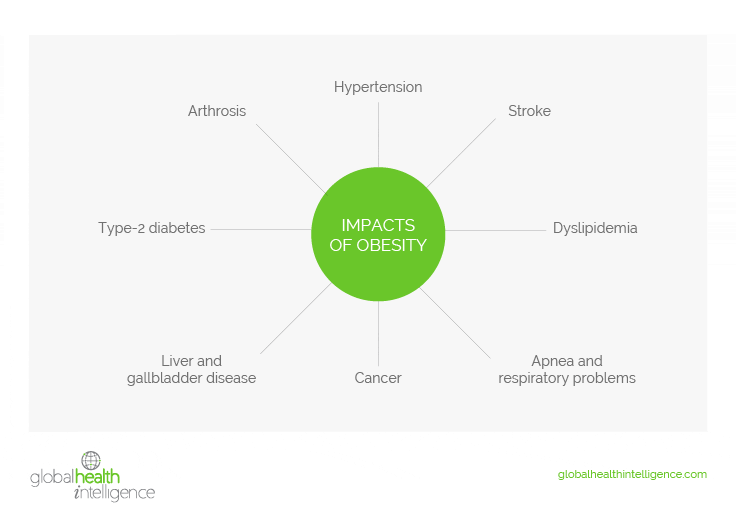The Impact of Obesity in Latin America
Latin America has become a region where obesity is a fact of life, and few even consider it a disease.
Obesity is the accumulation of fat in the body that can occur through genetic, hormonal, behavioral, and socioeconomic causes. Generally speaking, this disease happens when a person takes in more calories than what their body eliminates. These excess calories end up accumulating the body as fat.
This chronic illness manifests itself in varying degrees that are determined based on the patient’s body mass index:
- Type 1: moderate obesity
- Type 2: severe obesity
- Type 3: morbid obesity
- Type 4: extreme obesity
Cases have tripled over the past four decades, and the condition now affects more than 24% of people in the region, equivalent to over 100 million individuals, with obesity levels that amount to a serious problem of economic development and health, both physical and mental. Parallel to this, in recent years there has been a considerable increase in poverty that has led to increased malnutrition. What are the reasons for these events? How can there be an increase in obesity and malnutrition at the same time?
First of all, it is worth mentioning that our food habits have changed radically. We see the effects of globalization on our plates in the form of highly processed, sugary foods that have brought us to the grave situation we are experiencing today. We need to gain awareness of what we eat, be concerned about our health, and learn to invest time and money in our diet.
In combination with the change to our diet, technology has taken over our lives. We spend an increasing amount of time looking at screens and a decreasing amount doing exercise.
Obesity is a pervasive problem in our society, and its root cause is the energy imbalance between calories consumed and spent, influenced by socioeconomic problems.

We are leaving a rather bleak outlook for the coming generations, and we have to act quickly, as this epidemiological disease has grown 400% in the last four decades. In addition, COVID-19 deepened this crisis: children and teenagers have been affected by school closures, not only keeping them out of spaces for leisure and physical activity, but also out of school meals programs. But the same has happened with adults, who had to shut themselves away in their homes for long periods, full of work and a lot of uncertainty, two variables that add to anxiety and do little to help those suffering from obesity.
A persistent, harmful problem
In one of our investigations in which we interviewed patients and professionals in the sector, we found that the average age of patients with class-2 obesity is 35 to 45, and most of them have been obese since they were young. Obese people generally do not see a doctor until they feel they have hit bottom, as most think that what happens to them is their own fault because of their lack of willpower, and that medicine cannot offer them a solution.
Obesity affects the patient’s self-esteem, physical and emotional well-being, social dynamics, and career, and is a gateway to other pathologies. In order to prevent it we need a healthy diet combined with regular daily exercise. People whose genetics make them unable to control the disease on their own have various types of bariatric surgery options that are highly effective for losing weight.
Recommendations for Maintaining a Healthful Diet
The WHO has conducted several investigations into this issue, and the FAO has looked at nutrition in detail. Both organizations found a common denominator in relation to a healthful diet.
The key is in:
- Limiting the amount of processed foods or foods high in energy density
- Doing daily physical activity
- Eating fruit and vegetables several times a day
- Cooking at home
- Getting enough sleep—at least 7 hours a day
- Controlling our weight
Another Slimming Option
In addition to a healthful diet, some years ago science and technology joined forces to help people suffering from this serious illness by creating medical devices to help with weight-loss diets. All these devices are fitted by specialists in gastroenterology and bariatric surgery.
Bariatric surgery includes a range of surgical procedures depending on the pathology of the patient, but in all cases its impact is to reduce the size of the stomach to produce satiety. It is currently one of the most recommended options for addressing class-2 obesity or higher. It also considerably improves the patient’s quality of life, as it brings about real changes in the digestive system, achieving weight loss as well as the ability to maintain it over time. The success of this kind of procedure is proven when it comes to weight loss, but it can also bring patients other benefits, including lowering glycemia, blood pressure, and cholesterol levels, as well as improving sleep quality (as it can reduce or eliminate sleep apnea entirely) and reducing of the workload placed on the heart.

The Four Types of Bariatric Surgery
- A gastric bypass consists of a stomach reduction, creating a small gastric bag that restricts the intake of food to small volumes.
- A gastric band consists in placing an adjustable silicone band around the upper part of the stomach, thereby limiting its capacity and causing a sensation of satiety in the patient.
- A gastric sleeve is a technique whereby surgeons reduce the volume of the stomach by 80%, leaving it in a tubular shape similar to that of a banana, and with a capacity of 80 milliliters.
- A biliopancreatic bypass is a mixed surgical technique that halves the size of the stomach and modifies the length of the small intestine in order to limit the amount of food that can be consumed and therefore absorbed.
The downside of this kind of surgery are the potential side effects, including injuries to the intestine or stomach, vomiting, constipation, and low blood-sugar levels. However, according to our research, patients themselves see more positive aspects than negative ones, as their quality of life is infinitely better after the operations.
Next Steps
Contact us if you are interested in finding out more about the various hospitals that perform bariatric surgery in Latin America, the number of bariatric procedures performed, the equipment and models used, etc. We can design and conduct a personalized market survey that will provide all these data and more in order to help give you a better understanding of the opportunities for your business.





